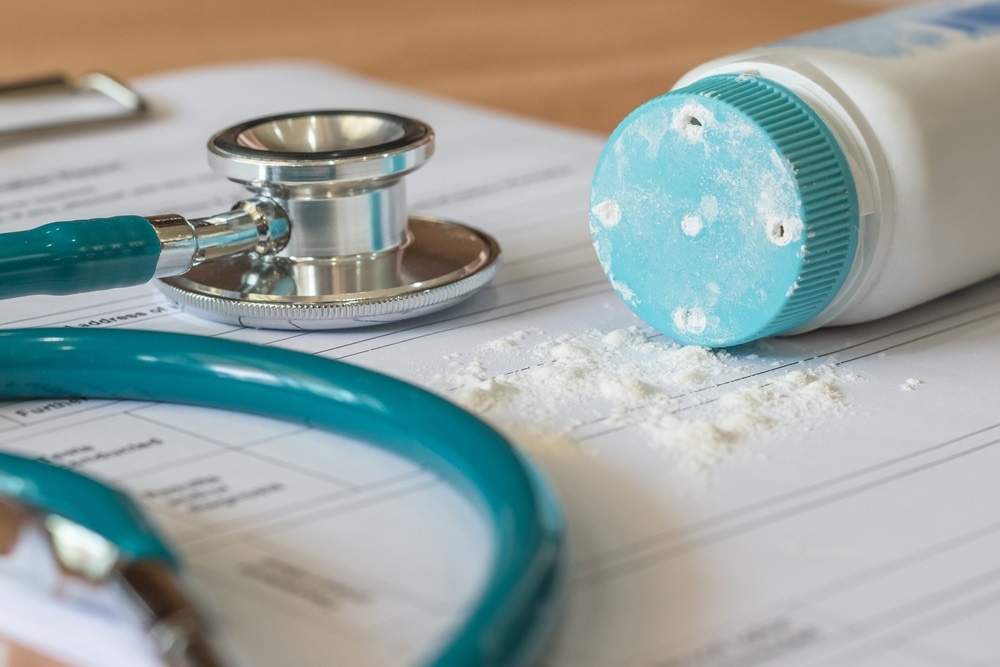According to the largest reported investigation to date, there is no significant association between using talcum powder or other powder products and an increased risk for ovarian cancer.
 Image Credit: Chinnapong / Shutterstock.com
Image Credit: Chinnapong / Shutterstock.com
The findings come following a slew of lawsuits against Johnson & Johnson fueled by reports of a potential link between the use of talc on the genital area and an increased risk for ovarian cancer.
The current study did not focus on the use of talc only, but most powder products do contain some mineral talc, note the authors.
Long-standing controversy
There has been a long-standing debate over whether using baby powder containing talc plays any role in the development of ovarian cancer.
In recent years, women have been taking talc manufacturers to court over concerns that using the product on the genital area could cause ovarian cancer. Concerns have been raised about the possibility of mineral talc being contaminated with asbestos, a known carcinogen. Most powder products contain a certain amount of mineral talc.
If the powder is used in this area, technically, it can enter the body and cause irritation and inflammation of the tissue in the fallopian tubes and ovaries, say the authors of the current study. This could then trigger a cascade of bodily responses, including oxidative stress and DNA damage that that may increase the risk for cancer.
In an accompanying editorial, professor of obstetrics and gynecology at the University of California, Dana Gossett, says earlier investigations of an association between the use of talc-containing powders for genital hygiene and epithelial ovarian cancer risk have provided inconsistent results and resulted in an "ongoing controversy."
However, the current study, recently published in JAMA, is unlikely to settle the controversy any time soon.
What did the study involve?
Researchers from NIH's National Institute of Environmental Health Sciences and the National Cancer Institute pooled data available for 252,745 women who answered questions about whether they used powder for genital hygiene, including the frequency and length of time they used the powder for.
The study found no statistically significant association between using talc-based powders or other powders and ovarian cancer.
The findings did reveal an 8% increased risk among women who used the powder products, compared with women who never used them, but head researcher Katie O'Brien says this "is not a statistically significant increase."
This increase needs to be understood in context, she says. Given that the lifetime risk of developing ovarian cancer is only 1.3% in the first place (1.3%), an increase of 8% to that is "small," representing an estimated increased risk of just 0.09% by the age of 70.
"Although this is the largest study ever done, our findings are not definitive… We found a small, but non-statistically significant, risk. We cannot establish causality. If there is a true association [between talc powder use and ovarian cancer], the increase would likely be very small," says O'Brien.
"The overall conclusion [is] that there is no demonstrable statistically significant association between use of powder in the genital area and ovarian cancer risk… This is the key finding of the study," writes the team.
"The risk is likely to be multifactorial"
When approached for comment, Don Dizon, director of women's cancers at Lifespan Cancer Institute in Providence, Rhode Island, pointed out that many factors can affect risk: "This is an example of the difficulties in concluding that any one factor increased the risk of ovarian cancer. The risk is likely to be multifactorial, and there are far better data to support other factors that also determine risk," he said. As examples, he referred to the protective effects of hormonal therapies, genetic risk, and familial predisposition to cancer.
In 2006, the International Agency for Research in Cancer classified the use of talc in the genital region as "possibly carcinogenic to humans." However, this is considered the weakest classification of cancer cause, which means the evidence to date is not yet clear.
The American Cancer Society also says that "findings have been mixed" and that, although there has been some suggestion of a possible increase in ovarian cancer risk, its bottom-line advice is: "until more information is available, people concerned about using talcum powder may want to avoid or limit their use of consumer products that contain it."
Journal reference:
O'Brien, K.M. et al. (2020). Association of Powder Use in the Genital Area With Risk of Ovarian Cancer. JAMA. DOI: 10.1001/jama.2019.20079.